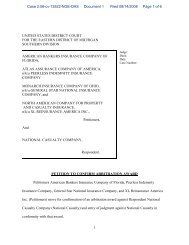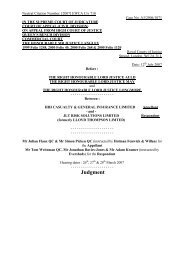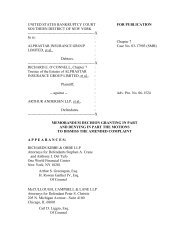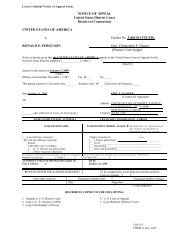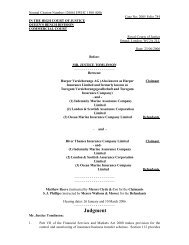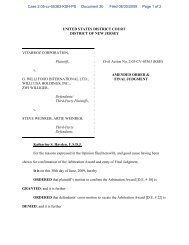Statutory Issue Paper No62R - Reinsurance Focus
Statutory Issue Paper No62R - Reinsurance Focus
Statutory Issue Paper No62R - Reinsurance Focus
Create successful ePaper yourself
Turn your PDF publications into a flip-book with our unique Google optimized e-Paper software.
Property and Casualty <strong>Reinsurance</strong><br />
SSAP No. 62R<br />
Practicability requires a reasonable basis for allocating the reinsurance premiums to the<br />
risks covered by the prospective and retroactive portions of the contract, considering all<br />
amounts paid or deemed to have been paid regardless of the timing of payment. If a<br />
reasonable basis for allocating the premiums between the prospective and retroactive<br />
coverage does not exist, the entire contract must be accounted for as a retroactive<br />
contract.<br />
30. Q: A retroactive reinsurance contract contains a cut-through provision that provides the<br />
ceding entity’s policyholders and claimants with the right to recover their claims directly<br />
from the reinsurer. May the ceding entity immediately recognize earned surplus<br />
associated with this type of contract?<br />
A: No. SSAP No. 62 states that earned surplus may not be recognized “until the actual<br />
retroactive reinsurance recovered exceeds the consideration paid.”<br />
31. Q: A ceding entity enters into a retroactive reinsurance agreement that gives rise to<br />
segregated surplus. If the reinsurer prepays its obligation under the contract, may the<br />
ceding entity recognize earned surplus at the time the prepayment is received?<br />
A: Segregated surplus arising from retroactive reinsurance transactions is earned as actual<br />
liabilities that have been transferred are recovered or terminated. Therefore, earned<br />
surplus is based on when the reinsurer settles its obligations to the ceding entity, and it<br />
may be appropriate to recognize earned surplus at the time the prepayment is received.<br />
However, all of the facts and circumstances must be considered to determine whether the<br />
ceding entity has substantively recovered the liabilities transferred to the reinsurer. For<br />
example, if the ceding entity agrees to compensate the reinsurer for the prepayment, such<br />
as by crediting the reinsurer with investment income on prepaid amounts or balances<br />
held, the ceding entity has not, in substance, recovered its transferred liabilities but rather<br />
has received a deposit from the reinsurer that should be accounted for accordingly.<br />
32. Q: If the ceding entity does not expect to receive any recoveries because the reinsurer has<br />
agreed to reimburse claimants under the reinsured contracts directly, would the ceding<br />
entity be considered to have recovered or terminated its transferred liabilities?<br />
A: No. In the example given, the reinsurer is substantively acting as disbursing agent for the<br />
ceding entity. Therefore, the ceding entity cannot be said to have recovered amounts due<br />
from the reinsurer before payment is made to the claimant.<br />
33. Q: What accounting entries would a ceding entity make to report a retroactive reinsurance<br />
contract?<br />
A: Accounting Entries for a Ceding Entity to Report a Retroactive <strong>Reinsurance</strong> Contract:<br />
Entry 1<br />
Retroactive <strong>Reinsurance</strong> Reserves<br />
Ceded or Assumed (B/S) 10,000<br />
Retroactive <strong>Reinsurance</strong> Gain (I/S) 2,000<br />
Cash 8,000<br />
© 2009 National Association of Insurance Commissioners 62-31


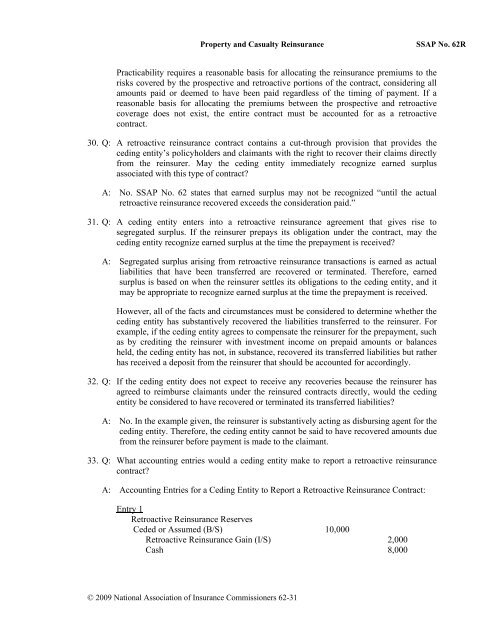
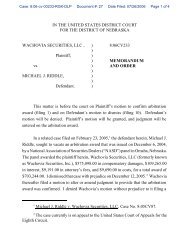
![202 Folio No 734 Neutral Citation Number: [2006] EWHC 1345 (QB ...](https://img.yumpu.com/50015000/1/184x260/202-folio-no-734-neutral-citation-number-2006-ewhc-1345-qb-.jpg?quality=85)
